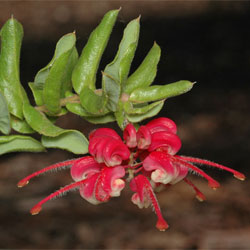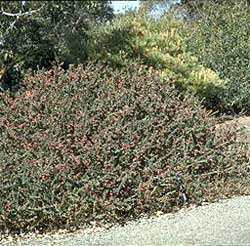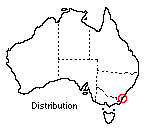Grevillea baueri
 |
 |
Bauer's Grevillea
This sturdy shrub from the mountain regions of New South Wales is a most desirable addition to the garden for its general hardiness and bright winter flowers. The species is variable in every way and a new plant begins early to develop its own individual habit, which may be spreading or upright; symmetrical or not. It may reach at least 1.5 m high, or 3 m across. Density of growth, leaf character and flower colour also vary according to the district of origin.

One form is upright and rounded, with a stiff open frame. The closely set leaves - a pleasant mid-green - are 2 centimetres long with wavy margins and rough upper surfaces, tough in character. Over the bold outline of the shrub individual flowers open, in heads about 5 cm across and blacken as they die. A conspicuous dark style extends stiffly from each flower and the colour is rich crimson with cream tints. The season starts in April, continuing all winter, with bright flushes during the mild showery spells. Flowers open well into November though somewhat eclipsed by the spring show.
Another form has attractive bushy growth, lighter and softer in character, and it tends to make a natural dome with graceful arching branches. A height of 1.3 m and a spread of 2 m at four years old is an example of typical rapid progress, and naturally it is a good large ground cover. Towards the end of winter new growing tips are freely made, giving coppery tints which are held for many weeks. At this time, the first flowers are opening in soft rose crimson, dotted all over the shrub.
Pruning is generally not necessary, but a little light pruning may be done to advantage if sprigs of flowers are taken for indoor decoration during winter. Seed is often found, but propagation is easy from cuttings, especially towards the end of winter, and short, half-ripe tips root readily in gentle heat. Plants may be bought from some nurseries dealing in native plants, and they succeed when planted in lime-free soils, preferably lighter ones. Adequate watering is desirable and avoids the risk of a check. Plants are generally healthy, though sometimes on close inspection aphids are noticed. This species will cross with others such as G. lanigera and G. rosmarinifolia to produce new and worthwhile subjects.
Based on text by Irene Beeton (1971)
Name meaning: Grevillea baueriGrevillea - after C. F. Greville, a patron of botany, and once vice-president of the Royal Society of London; baueri - after German brothers Bauer, botanical illustrators |
![An Australian Government Initiative [logo]](/images/austgovt_brown_90px.gif)

